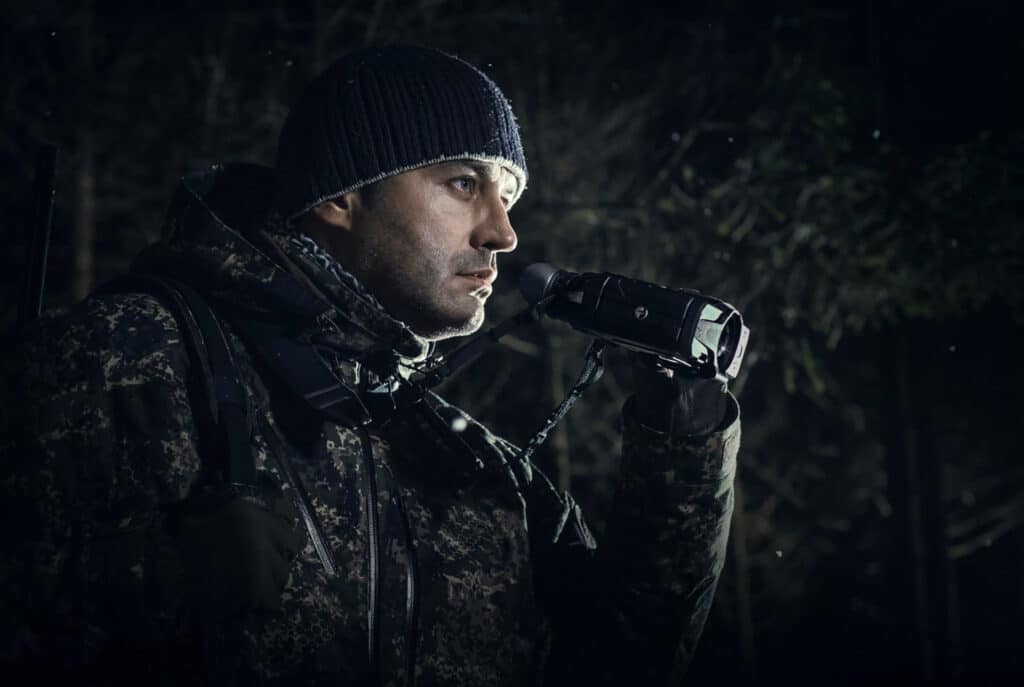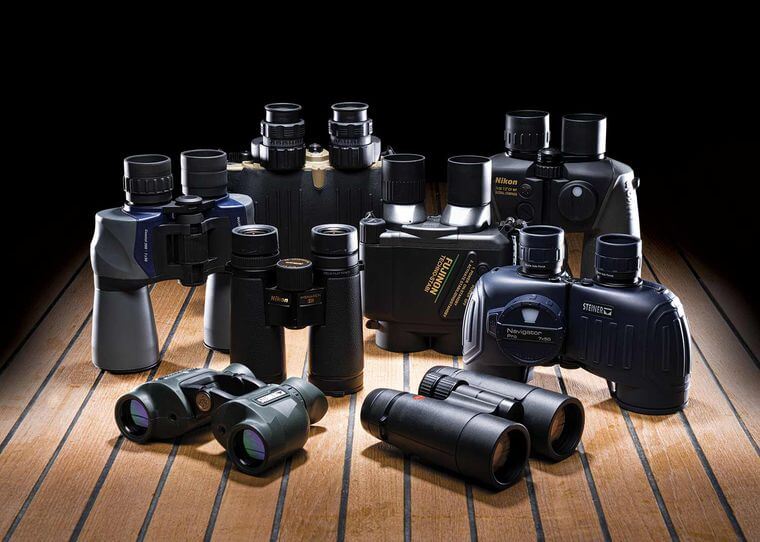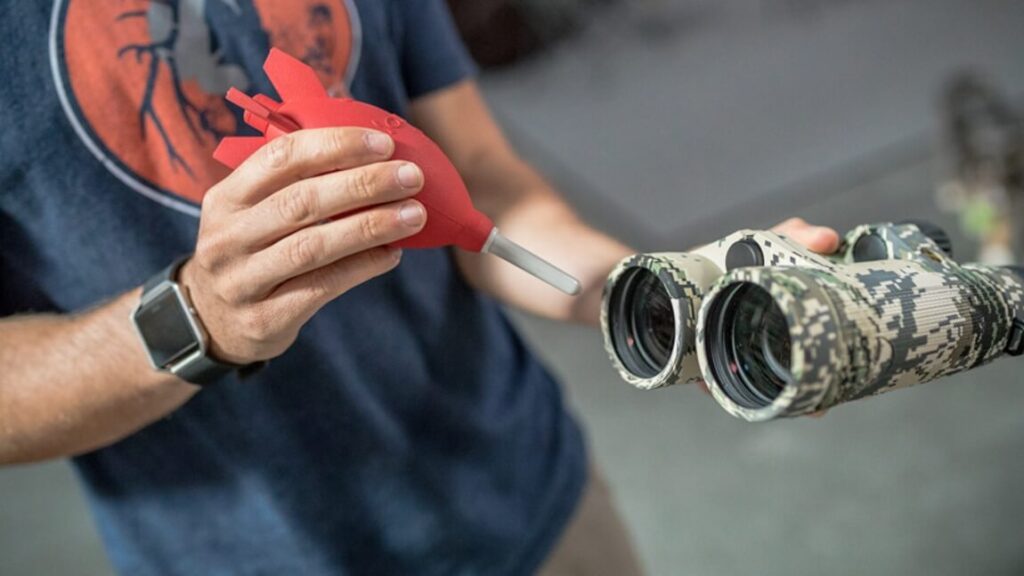

The human eye can do a lot, but it is not perfect. Most of the creatures in the animal kingdom, both birds and mammals, have evolved to make sure that they are not seen. So, it is no surprise that binoculars were invented. What binoculars accomplish is well-known: They let you see things that are far away. But what we have found to be most valuable are the binoculars that go even further than that, such as the Vortex Kaibab and its phase correction filtering or the Steiner M2080 and its nitrogen injection system that keeps it fog-proofed.
What we are looking at today is the best binoculars that stand out. If you are going out into nature, you need to be able to identify flora and fauna well in advance of running into it. And that means your binoculars need to be a cut above the rest.
There are some binoculars that are good for viewing things distantly and some that are good for viewing things clearly. But few can see as far or with as much clarity as extreme distances as the Vortex Kaibab.
With 18x magnification and phase filtering technology to clear up any image, you can count the dots on the wings of a butterfly with this pair of binoculars. The Vortex Kaibab is a state-of-the-art pair of binoculars with a roof prism system made of BAK4 material. Simply put, that means it offers the clearest image money can buy. This is all protected by a layer of rubber armor that only weighs a little bit over a kilogram.
What really sets this pair of binoculars apart is its ability to interpret distant images—obviously a mainstay feature of any pair of binoculars. But many binoculars can only bend light to allow you to see a very small region with any clarity. The Vortex Kaibab uses special technology to filter out visual interference from the lens.
This is particularly noticeable when you compare the binoculars to sets like the Athron Optics binoculars. Lacking this filtering, the extreme zooms that those binoculars are capable of simply feel like viewing images through a pinhole. The Vortex Kaibab is one of the few to give you a complete image.
There is a lot going on under the hood in the Steiner M2080. It delivers an extremely high magnification with advanced auto-focusing to help you get a bead on anything you point it at. But that’s not why these binoculars cost $2000. The cost is much because they don’t just work in rough environments. They excel there. Steiner’s M2080 binoculars are like a marble sculpture. Featuring a porro prism system that keeps all the power of magnification safe from wear, tear, and light damage, these bad boys have 20x magnification in the rain, sleet, or shine.
The reason they work in so many different environments starts somewhere obvious: A waterproofed treatment. The plastic has been coated with a chemical agent that repels water from sticking to it. That means rather than water just not damaging it, and water can’t even soak into it, making them dry and easy to grip. Along with that, they also have a nitrogen injection system that uses an internal pressure system to prevent the lenses from fogging up.
What most binoculars will do to draw focus is use what is called a “diopter” set that reacts to the light hitting the lenses to pull or push focus. The porro system of lenses instead uses a complex system of reflections to do a similar thing, adding up to a far more durable lens system by reducing motion in it.
With a lightweight and affordable price, there are few places that are better to start with binoculars than the Celestron Skymaster. Originally made for birdwatching, this brand has expanded to include all manner of uses in their binoculars’ design. Of particular note is the dynamic focus, allowing you to examine objects as close as 43ft away or throw your gaze to something as far away as 15x that.
Most customers who review the Celestron SkyMaster do so as hobbyists. But every so often, an old veteran camper, hiker, or hunter will come along and try them out. Do you know what they say? They say that there are few binoculars with as powerful lenses for their size or as accurate focuses for their cost.
Part of the accuracy of the focus system comes from the fact that it is manual. Some people will shudder at the thought of manually adjusting focus, but most people know that this is the only way to do it accurately. The Celestron Skymaster makes this particularly easy with a notched, low-resistance tuner, meaning you will feel every step of focus you are shifting down.
Most people compare the Skymaster to binoculars of similar prism systems, such as the Steiner M2080. They fall short in terms of magnification when compared to those due to a difference in the basic lens size. But you are going to find a few other binoculars with the same prism system at this price, making the comparison more flattering the longer you think about it.
Whether it’s sweltering heat or crippling cold, you need a pair of binoculars that can handle any environment. Athlon Optics provides that with these binoculars, sporting several different layers of protective coating for different situations. Not only that, but they use a special metal casing to stay durable while also being lightweight. And they are one of the few sets that use phase prism technology to clarify images.
The first thing that protects them is the magnesium case. It is as tough as steel, but more than a third lighter after that is the ESP dielectric coating, which keeps the lenses from suffering sun damage. Then, the XPL coating is a must-have for keeping dirt and scratches from compromising the case. Finally, the rubber armor around all of this is argon-proofed to keep water from soaking in.
This is the recipe for a pair of binoculars that can go anywhere, like these ones. This is what the Athlon Optics Midas Gen II is made of. And to the surprise of no one, it makes the binoculars feel indestructible. But not only that, it allows them to be lightweight and easy to manage. They are smaller and lighter than most, meaning that while they can take a beating, they won’t slow you down.
Something that many people latch onto when they see the Midas’ specifications is its magnification. And yes, it is smaller than something like the Celestron Skymaster. But it compensates for this by using phase prism technology to make that image much clearer.
There are some people who prefer a thick pair of binoculars that you have to carry around in a backpack like it’s a piece of specialized machinery. But there are others that like binoculars that dangle off your neck and don’t get in the way. That second category is where the Huskemaw Blue Diamond Optics find themselves. They are small, cheap, and built for medium-range viewing. This makes them perfect for beginners and people who want something low-maintenance.
These binoculars solve a problem that everyone just starting out with a hobby needs to solve: Being usable. There is no complex prism system—it is the standard roof prism system. Nor is there a manual focus. There are two lenses that have 10x magnification, waterproofing, and long eye reliefs for glasses wearers.
The lightweight build compliments the automatic focus, providing a “quick draw” feeling to the binoculars. And their small size means that they can fit into a pocket when folded up or a smaller pouch on a backpack. There is no need to organize your whole kit around them.
This description of the binoculars probably makes them sound like they are lacking in features compared to something like the Steiner M2080. And that is true; the list of what they are not is much longer than the list of what they are. But not every pair of binoculars is trying to reinvent the wheel. The greatest advantage that the Blue Diamond Optics binoculars bring is the fact that you know exactly how to use them as long as you know what binoculars are.
With a name like “Predator,” you know the Steiner Predator binoculars are looking to be at the top of the food chain. By that, we, of course, mean they do an impressive job of making any hunt easier. The Predators are also built to last with a special casing meant to let them endure rain and wind and resist scratches. This keeps them good to use in any environment without having to concern yourself with whether or not mother nature is going to take issue with them.
One of the most important things for a pair of binoculars to offer a hunter is high contrast. Animals know how to blend into their environments. They would not last long if they didn’t. But while our eyes can spot them hiding in many different situations, by the time that happens, we are usually so close that we will scare them off. Enter the Steiner Predator binoculars.
Using a color-adjusted transmission system, the Steiner Predator binoculars adjust your image to be at the peak of the human eye’s ability to read contrast. This is less common than you might think among binoculars, where usually, the magnification of the image causes colors to blend together. With this system, you can make better use of their fast-focus function, which makes sure that your focus is maintained even if you are moving your sights.
Most other hunters go for more durable products like the Celestron Skymaster due to all of the steps taken to keep them from getting damaged. And indeed, by that measure, the Steiner Predator is not as versatile. But most hunters assume that the contrast the Predator brings won’t make a difference. What many hunters find is that it completely changes the way they hunt.
One of the most frustrating things to deal with when using binoculars is fog and moisture. The focus systems of most binoculars are light-based, meaning things that create inconsistent lighting conditions like fog can make focus malfunction. The Vortex Razor is named as such because it seems to cut through the moisture in the air with its fog-resistant lenses and high-end focus technology. This probably makes the Vortex Razor sound like some complicated machinery, but they are really not. There are few pairs of binoculars that are built to be this intuitive, giving the whole structure a sleek and futuristic feel.
The Vortex Razor has a lot of features that you might never know it had if you didn’t look them up. Most design philosophies concur that this is a good way to make an intuitive product: You get mad when your binoculars get scratched, or you can’t see anything. You do not have a reaction of amazement when they are not scratched and can see things perfectly. Staying intact and seeing things are the default functions.
But as we said at the outset, the Vortex Razor is actually unnaturally good at keeping from getting scratched, waterlogged, or wearing down in any other way. This is due to the durable rubber armor and argon coating, both of which work to protect it. Meanwhile, its vision is cleared up by low-dispersion glass that prevents lighting artifacts from interfering with focus. It is like night and day how much this impacts binoculars, so you will probably be surprised at how much it clears up an image.
The closest point of comparison the Vortex Razor has is the Huskemaw Blue Diamond Optics, as they are both designed to be easy to use rather than feature-heavy. These have the drawback of being a bit more expensive, but they more than makeup for that when you take into account how advanced their image clarification systems are.
Don’t be fooled by the low magnification—the focus of the Nikon M7 is its wide interpupillary range. What does that mean? It is something that many photographers will be familiar with. That means its focus can be shifted between a long, detailed focus or a short, cinematic focus. This combines with its wide field of view and precise handling to make it one of the best pairs of binoculars for photography out in nature, where tons of different variables are at play at a given time. It also happens to make it good for advanced users who want to maximize the features that their money goes to.
You might know the Nikon name as a brand of cameras such as these. If you do, it will probably not surprise you that they know their way around a lens structure. Nowhere is this clearer than the Nikon M7 binoculars, one of the most advanced pairs of binoculars on the market. But “advanced” does not mean “best,” as it is clear that these binoculars have a purpose.
What the Nikon M7 binoculars offer is rather complex. You see, it is not trying to help you spot anything specific in the environment. It is a pair of binoculars designed to help you view the environment like a camera might. That means while it does not have adjustable magnification, it has a highly adjustable focus. It can both rack focus as well as expand and contract its focus to give you a better idea of how a camera will interpret the image. It does this by combining lenses of slightly different widths so that a huge range of focus options is available.
It is somewhat hard to compare the Nikon M7 directly to anything else, as most other binoculars are designed with something like hunting or birdwatching in mind. Due to being geared towards such a different hobby, it is best to compare it to the Steiner Predator, as they are both specialized devices. And when you think of it like that, its design makes more sense, as in both cases, the binoculars give up some standard features for something that you cannot get anywhere else.
That is a ton of information to take in, so let’s break it down into something simpler. When you shop for binoculars, every brand and product is working as hard as it can to catch your eye. And they all say they are the best. But the best binoculars are the binoculars that do what you need them to do. What we will do not break down which features a pair of binoculars can have and talk a bit about which binoculars best exemplify these features.
Viewing from a distance is the main thing a pair of binoculars is meant to do. It allows you to see far-away objects in great detail. But that is casting an incredibly broad net. Consider what the Steiner Predator does: clarifying an image. It allows us to not only see things but tell them apart in minute ways. The Vortex Kaibab is focused more on clearing up the image to make it more in line with what your eye would ordinarily see. This means it will give you a greater sense of the whole image rather than amplifying the colors as the Predator does.
The basics of binoculars are their ability to magnify distant objects, as well as the diameter of their lenses which determines how much light gets into them. They do this through a prism system, which can either be a roof-mounted prism system or a multi-lensed porro prism system.
Eye relief is important for determining how easily you can use binoculars. This is related to the field of view of the binoculars too, and even how close something can be before you lose focus on it.
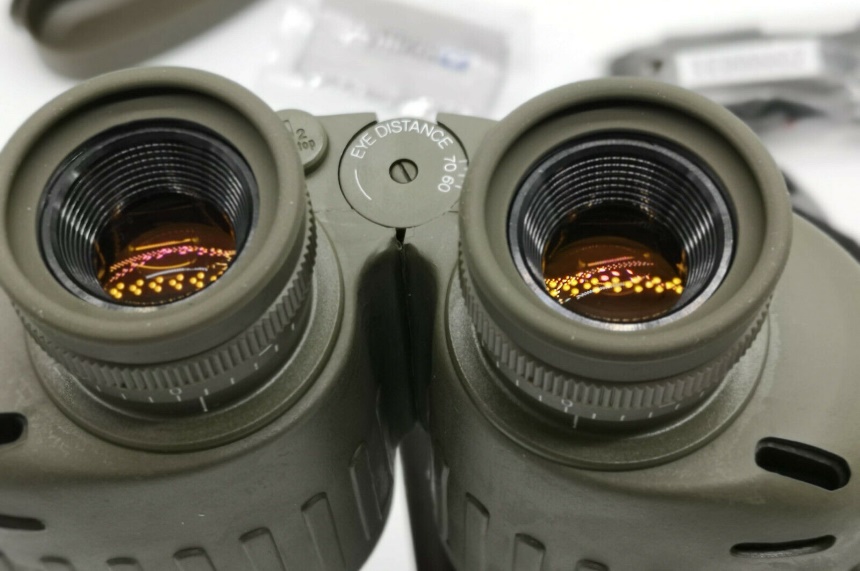
Most people assume that magnification is the most important feature of a pair of binoculars. And most times, they are right. If you want to view something from far away, you probably want the option to be as far away as possible. This is why the Steiner M2080 is better for hunters than the Steiner Predator, even though the latter was made for hunting.
The amount of light that gets let into your binoculars determines how sharp the image is, and that is, in turn, determined by the objective diameter of the lens. This also relates to the size of the binoculars. Binoculars like the Vortex Kaibab are going to be heavier than the Nikon M7 simply because their lenses are wider.
The prism system of a pair of binoculars is simpler than it sounds. It is the method by which magnification is achieved. Basically, binoculars like the Vortex Razor use a “roof” prism system, which means that the prisms are aligned linearly. One magnifies another, which is magnified by the next.
Porro prism systems give better magnification but use more lenses, meaning more weight. They do this with multiple lenses reflecting off of each other, amplifying the image in that way.
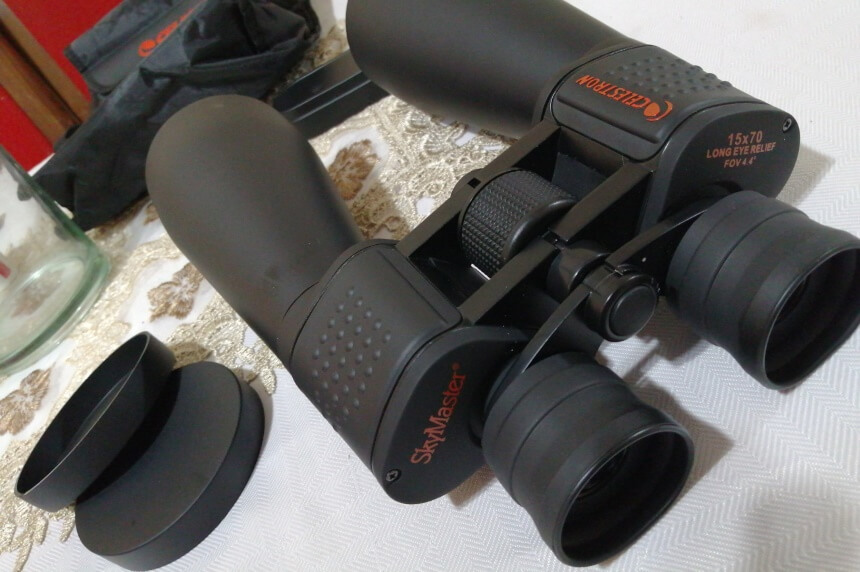
You definitely want to find an eye relief that is not burdensome to look through. It should be padded with rubber and be wide enough for your glasses or eye protection if you have any. This is why the Celestron Skymaster has wide eye reliefs: It makes their binoculars accessible.
Some binoculars get away with giving a portal, a telescopic look. But most people can feel how restrictive this is. Field of view determines how much of your image feels natural and how much is obstructed by the binoculars themselves. The Nikon M7 is a good example of binoculars that need a wide field of view, going with their design of being similar to a camera lens.
A pair of binoculars with good close focus means that they can focus on something that is closer to you. If you hold your hand over the lens of a pair of binoculars, it will appear blurry. The closer your close focus, the closer something can be before your binoculars can’t focus on it. Going back to the Nikon M7 again, those binoculars need close focus for their photography uses and indeed have the closest focus of the products on this list.
The main thing that determines how versatile a pair of binoculars are is how many different situations they can function in. The Athlon Optics Midas Gen II is a good example of this, as they are built to deal with not only rain and fog but also scratches and impacts.
We covered a lot of ground today, but it is probably pretty clear that the Vortex Kaibab is our Editor’s Choice. It is simply too powerful to ignore, combining an insane magnification range with durability and versatility to make it a pair of the best long-distance binoculars out there. The Steiner M2080 is no joke, though. It comes away as our premium pick. Its price is high, but when you use it, you will feel like you are holding the Mt. Everest of binoculars. The durability and features it brings are worth it. But for the best value, you will want to go with the Celestron SkyMaster. There are not many binoculars that provide such good imagery for such a low price. Whichever product you pick, however, you will have a hard time going wrong. Just so long as you keep in mind what job you have to do with them.
